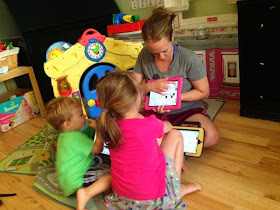I hated that I was drowning in "the easy part" . . . but he was right. You fight for a system, you get a system, and then you look at it and think, "Well then. So, um, here you go? Can't wait to hear all of the stuff you want to say! Hop to it!" The truth of the matter is simple, and I've heard the piano analogy used again and again to explain it to new AAC families/professionals: being given an AAC system doesn't make someone a proficient AAC user anymore than being given a piano makes someone a proficient pianist. There must be teaching, practice, and frequent use of the device/instrument.
The type of teaching that is, far and away, the most successful for AAC users is called Aided Language Input. No, it's called Aided Language Stimulation. No wait, it's called Modeling. Actually those are just different terms for the same thing---and the main idea is simple: If you want someone to use an AAC device to communicate, you have to use the AAC device to communicate. If you want to help a user see how to locate words and build phrases, you must model how to locate words and build phrases.
modeling for my kids (I'd rather sit next to them while modeling, but there had just been a who's-sitting-in-mom's-lap seating battle. 2 kids + 3 talkers + 1 lap does not = success)
Think for a second about the way that adults model language for babies--we expect that they will speak, and so we speak to them so that they have hours and hours of input before they begin speaking back:
The typically developing child will have been exposed to oral language for approximately 4,380 waking hours by the time he begins speaking at about 18 months of age.Compare that to a child using AAC, who may only have modeling/teaching on the system during speech sessions (in this example, twice a week):
If someone is using a different symbol set and only has exposure to it two times a week, for 20 – 30 minutes each, it will take the alternate symbol user 84 years to have the same experience with his symbols that the typically developing child has with the spoken word in 18 months!!! -Jane KorstenShocking, right? The first time I heard that Korsten quote (which I broke into two pieces above) I wanted to run home and start modeling constantly in an attempt to even the playing field.
Here are a few resources about modeling/ALI/AlgS* to get you started:
- Need to quickly sum up what ALI is for someone new to the idea who needs to get a quick intro and jump in (your child's teacher? your client's parent?)? This 2-page bright, colorful handout (with references) is a good start.
- So now you know you should model, but how? Which words? How many words? This blog post from Speak for Yourself, Simon Says: Model One More Word, gives concrete guidance and examples as to how to model in a way that will both meet your child where he/she is and also help to push for longer utterances.
- PrAACtical AAC is practically (praactically?) the best AAC resource around. They have several posts about aided language input, which have been rounded up here: Pivotal Skills for AAC Intervention: Aided Language Input. You can also see more posts by following their tag for aided language input (and since you're checking out their page I'd recommend you follow them on Facebook, too).
Stay tuned tomorrow for Take-a-Look Tuesday, where I'm going to feature videos that show ALI in action!
*the abbreviation used for "aided language stimulation" is AlgS, so as to avoid confusion with amyotrophic lateral sclerosis (ALS).

Hello mate nice bllog
ReplyDelete